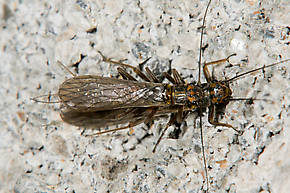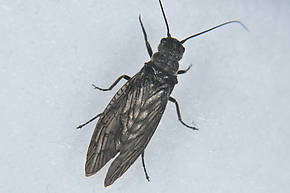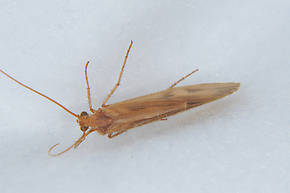Blog & Latest Updates
Fly Fishing Articles
Insects by Common Name


> > The Touchet River
Closeup insects from the Touchet River
Male Acentrella turbida (Tiny Blue-Winged Olive) Mayfly Spinner View 3 PicturesI would not like to have to match this hatch. These are the smallest mayflies I have ever seen. I used to think Caenis was the smallest adult mayfly in the west but these guys are about 4mm long. The male eyes are two toned, brown above and olive below. The abdomen is dark brown interspersed with light brown. The abdomen is clear for the anterior (Anterior: Toward the front of an organism's body. The phrase "anterior to" means "in front of.") 2/3rd and the remainder is white. The tails are twice as long as the insect. There is only one pair of wings.
View 3 PicturesI would not like to have to match this hatch. These are the smallest mayflies I have ever seen. I used to think Caenis was the smallest adult mayfly in the west but these guys are about 4mm long. The male eyes are two toned, brown above and olive below. The abdomen is dark brown interspersed with light brown. The abdomen is clear for the anterior (Anterior: Toward the front of an organism's body. The phrase "anterior to" means "in front of.") 2/3rd and the remainder is white. The tails are twice as long as the insect. There is only one pair of wings.
 View 3 PicturesI would not like to have to match this hatch. These are the smallest mayflies I have ever seen. I used to think Caenis was the smallest adult mayfly in the west but these guys are about 4mm long. The male eyes are two toned, brown above and olive below. The abdomen is dark brown interspersed with light brown. The abdomen is clear for the anterior (Anterior: Toward the front of an organism's body. The phrase "anterior to" means "in front of.") 2/3rd and the remainder is white. The tails are twice as long as the insect. There is only one pair of wings.
View 3 PicturesI would not like to have to match this hatch. These are the smallest mayflies I have ever seen. I used to think Caenis was the smallest adult mayfly in the west but these guys are about 4mm long. The male eyes are two toned, brown above and olive below. The abdomen is dark brown interspersed with light brown. The abdomen is clear for the anterior (Anterior: Toward the front of an organism's body. The phrase "anterior to" means "in front of.") 2/3rd and the remainder is white. The tails are twice as long as the insect. There is only one pair of wings.Collected July 27, 2011 from the Touchet River in Washington
Added to Troutnut.com by Bnewell on July 27, 2011
Added to Troutnut.com by Bnewell on July 27, 2011
Male Rhithrogena morrisoni (Western March Brown) Mayfly Spinner View 2 Pictures
View 2 Pictures
 View 2 Pictures
View 2 PicturesCollected April 20, 2012 from the Touchet River in Washington
Added to Troutnut.com by Bnewell on April 21, 2012
Added to Troutnut.com by Bnewell on April 21, 2012
Female Claassenia sabulosa (Golden Stone) Stonefly Adult View 3 PicturesI think this is one of the most poorly understood of the golden stoneflies. It is rare to see any articles about it or fishing the hatch. It emerges late in summer usually on medium to large rivers.The adults are quite secretive but it is something to see the adults run across the water surface. These guys can really run. The males have short wings.The females are up to 1 1/4 inch long rivaling the salmonfly as the largest adult stonefly in the west.The adults are not real golden in color, especially the females which are more of an off yellow to off white abdomen. In handling the adults it is obvious that they shun direct sunlight. I find them by turning over rocks close to the water's edge.
View 3 PicturesI think this is one of the most poorly understood of the golden stoneflies. It is rare to see any articles about it or fishing the hatch. It emerges late in summer usually on medium to large rivers.The adults are quite secretive but it is something to see the adults run across the water surface. These guys can really run. The males have short wings.The females are up to 1 1/4 inch long rivaling the salmonfly as the largest adult stonefly in the west.The adults are not real golden in color, especially the females which are more of an off yellow to off white abdomen. In handling the adults it is obvious that they shun direct sunlight. I find them by turning over rocks close to the water's edge.
 View 3 PicturesI think this is one of the most poorly understood of the golden stoneflies. It is rare to see any articles about it or fishing the hatch. It emerges late in summer usually on medium to large rivers.The adults are quite secretive but it is something to see the adults run across the water surface. These guys can really run. The males have short wings.The females are up to 1 1/4 inch long rivaling the salmonfly as the largest adult stonefly in the west.The adults are not real golden in color, especially the females which are more of an off yellow to off white abdomen. In handling the adults it is obvious that they shun direct sunlight. I find them by turning over rocks close to the water's edge.
View 3 PicturesI think this is one of the most poorly understood of the golden stoneflies. It is rare to see any articles about it or fishing the hatch. It emerges late in summer usually on medium to large rivers.The adults are quite secretive but it is something to see the adults run across the water surface. These guys can really run. The males have short wings.The females are up to 1 1/4 inch long rivaling the salmonfly as the largest adult stonefly in the west.The adults are not real golden in color, especially the females which are more of an off yellow to off white abdomen. In handling the adults it is obvious that they shun direct sunlight. I find them by turning over rocks close to the water's edge.Collected August 3, 2011 from the Touchet River in Washington
Added to Troutnut.com by Bnewell on August 3, 2011
Added to Troutnut.com by Bnewell on August 3, 2011
Isoperla fulva (Yellow Sally) Stonefly Adult View 2 Pictures
View 2 Pictures
 View 2 Pictures
View 2 PicturesCollected May 6, 2012 from the Touchet River in Washington
Added to Troutnut.com by Bnewell on May 6, 2012
Added to Troutnut.com by Bnewell on May 6, 2012
Male Sialis hamata Alderfly Adult View 2 Pictures
View 2 Pictures
 View 2 Pictures
View 2 PicturesCollected May 15, 2012 from the Touchet River in Washington
Added to Troutnut.com by Bnewell on May 18, 2012
Added to Troutnut.com by Bnewell on May 18, 2012
Male Baetis tricaudatus (Blue-Winged Olive) Mayfly Adult View 2 Pictures
View 2 Pictures
 View 2 Pictures
View 2 PicturesCollected May 16, 2012 from the Touchet River in Washington
Added to Troutnut.com by Bnewell on May 18, 2012
Added to Troutnut.com by Bnewell on May 18, 2012
Onocosmoecus unicolor (Great Late-Summer Sedge) Caddisfly Adult View 2 Pictures
View 2 Pictures
 View 2 Pictures
View 2 PicturesCollected October 5, 2011 from the Touchet River in Washington
Added to Troutnut.com by Bnewell on October 11, 2011
Added to Troutnut.com by Bnewell on October 11, 2011
Suwallia pallidula (Sallfly) Stonefly Adult View 2 Pictures
View 2 Pictures
 View 2 Pictures
View 2 PicturesCollected July 1, 2011 from the Touchet River in Washington
Added to Troutnut.com by Bnewell on July 1, 2011
Added to Troutnut.com by Bnewell on July 1, 2011
Pteronarcys californica (Giant Salmonfly) Stonefly Nymph View 2 PicturesHere are two size classes of Pteronarcys nymphs. These probably represent two different generations. The largest will probably emerge next spring and the other in two years. There is probably another generation, smaller, I did not collect. In a Canadian study they discovered Pteronarcys eggs do not all hatch simultaneously but hatch for a period of nearly two years, making their egg/nymphal life 5 years. The other photo is of a curled nymph, a typical response to disturbance.
View 2 PicturesHere are two size classes of Pteronarcys nymphs. These probably represent two different generations. The largest will probably emerge next spring and the other in two years. There is probably another generation, smaller, I did not collect. In a Canadian study they discovered Pteronarcys eggs do not all hatch simultaneously but hatch for a period of nearly two years, making their egg/nymphal life 5 years. The other photo is of a curled nymph, a typical response to disturbance.
 View 2 PicturesHere are two size classes of Pteronarcys nymphs. These probably represent two different generations. The largest will probably emerge next spring and the other in two years. There is probably another generation, smaller, I did not collect. In a Canadian study they discovered Pteronarcys eggs do not all hatch simultaneously but hatch for a period of nearly two years, making their egg/nymphal life 5 years. The other photo is of a curled nymph, a typical response to disturbance.
View 2 PicturesHere are two size classes of Pteronarcys nymphs. These probably represent two different generations. The largest will probably emerge next spring and the other in two years. There is probably another generation, smaller, I did not collect. In a Canadian study they discovered Pteronarcys eggs do not all hatch simultaneously but hatch for a period of nearly two years, making their egg/nymphal life 5 years. The other photo is of a curled nymph, a typical response to disturbance.Collected August 10, 2011 from the Touchet River in Washington
Added to Troutnut.com by Bnewell on August 10, 2011
Added to Troutnut.com by Bnewell on August 10, 2011
Dicosmoecus gilvipes (October Caddis) Caddisfly Adult View 2 Pictures
View 2 Pictures
 View 2 Pictures
View 2 PicturesCollected September 5, 2010 from the Touchet River in Washington
Added to Troutnut.com by Bnewell on June 27, 2011
Added to Troutnut.com by Bnewell on June 27, 2011
Start a Discussion of the Touchet River:
Top 10 Fly Hatches
Top Gift Shop Designs
Eat mayflies.
Top Insect Specimens
Miscellaneous Sites
Troutnut.com is copyright © 2004-2024 Jason
Neuswanger (email Jason). See my FAQ for information about use of my images.
 privacy policy
privacy policy
